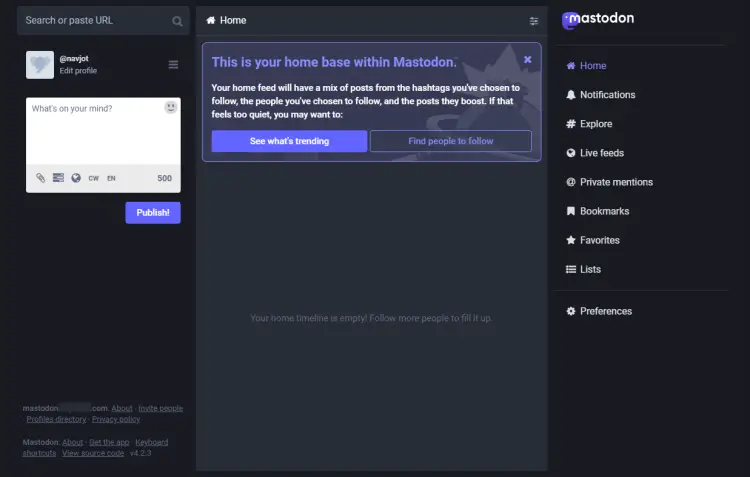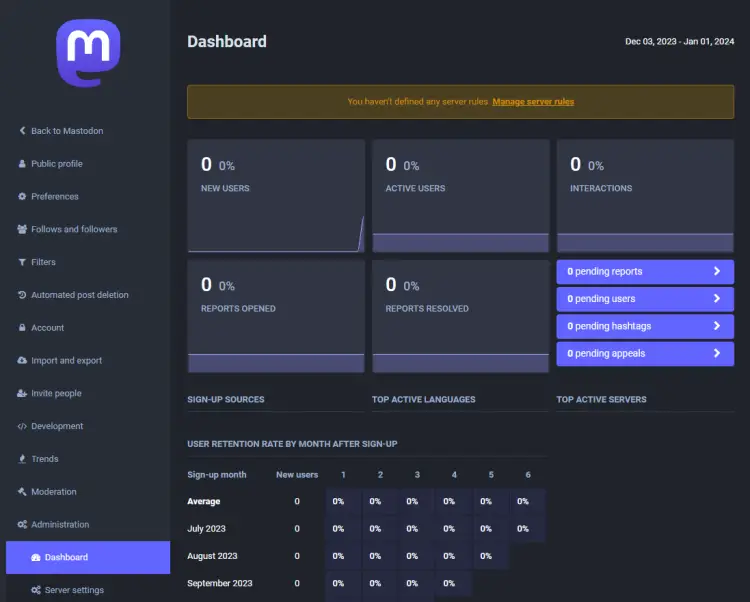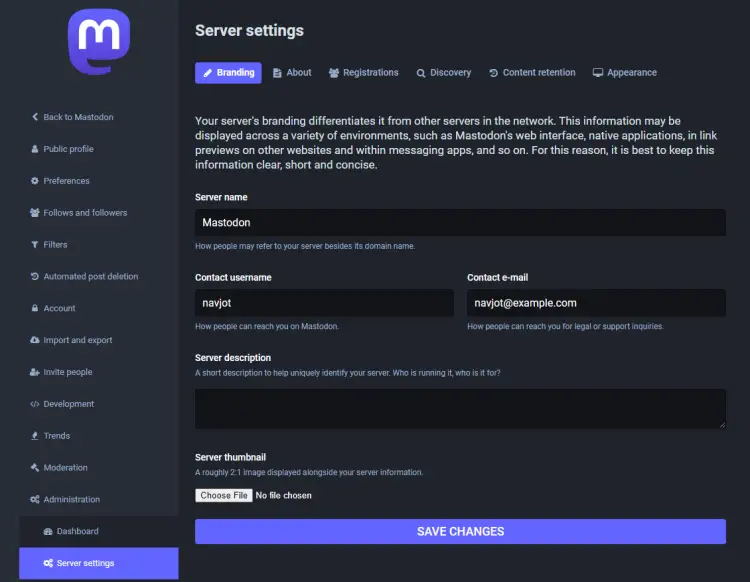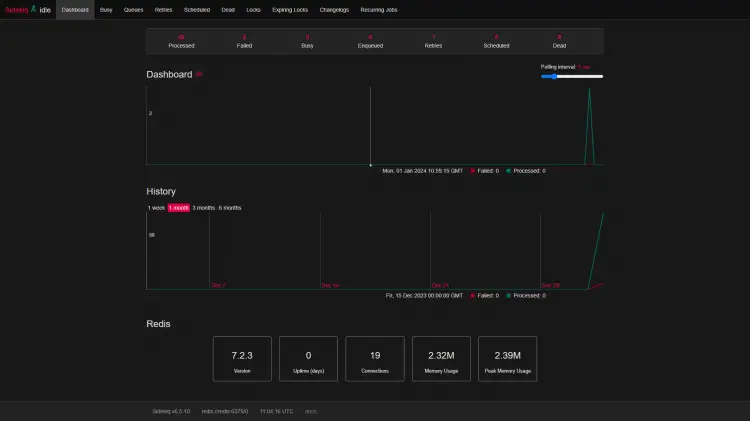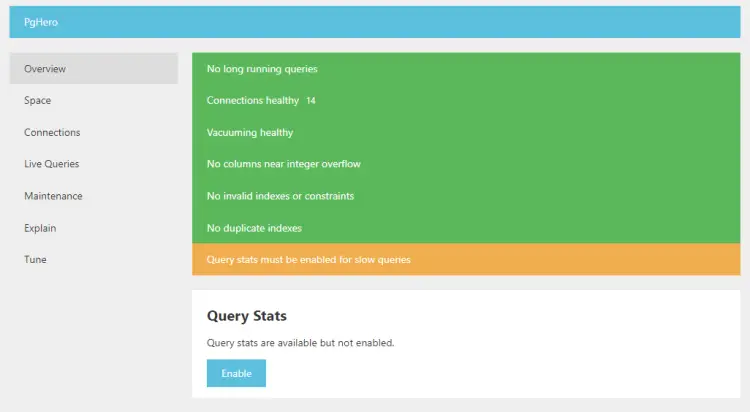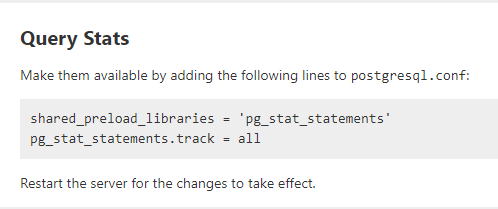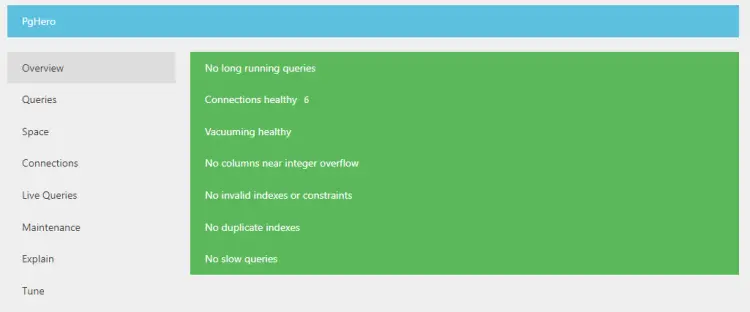How to Install Mastodon Social Network on Debian 12
This tutorial exists for these OS versions
- Debian 12 (Bookworm)
- Debian 11 (Bullseye)
- Debian 10 (Buster)
On this page
- Prerequisites
- Step 1 - Configure Firewall
- Step 2 - Install Docker and Docker Compose
- Step 3 - Preparing for Installation
- Step 4 - Install Mastodon
- Step 5 - Install Nginx
- Step 6 - Install SSL
- Step 7 - Configure Nginx
- Step 8 - Start Mastodon
- Step 9 - Mastodon Maintenance
- Step 10 - Backup Mastodon
- Step 11 - Upgrade Mastodon
- Conclusion
Mastodon is a free, decentralized, and open-source social network. It was created as an alternative to Twitter. Just like Twitter people can follow each other, and post messages, images, and videos. But unlike Twitter, there is no central store or authority for the content.
Instead, Mastodon operates across thousands of different servers each run by various members of the community. Users signed up on one server can easily connect to users on the other network and follow each other across instances.
Anyone can install their instance of a Mastodon server. This tutorial will teach you how to set up your instance of Mastodon on a server with Debian 12 using Docker. Docker makes it easy to install Mastodon by containing all the packages and services required in containers.
Prerequisites
-
A server running Debian 12 with a minimum of 2 CPU cores and 2GB of memory. You will need to upgrade the server as per requirements.
-
A non-root user with sudo privileges.
-
A fully qualified domain name (FQDN) pointing to your server. For our purposes, we will use
mastodon.example.comas the domain name. -
Mastodon sends email notifications to users. We recommend you use a 3rd party Transactional mail service like Mailgun, SendGrid, Amazon SES, or Sparkpost. The instructions in the guide will be using Amazon SES.
-
Make sure everything is updated.
$ sudo apt update
-
Install basic utility packages. Some of them may already be installed.
$ sudo apt install curl wget nano software-properties-common dirmngr apt-transport-https ca-certificates lsb-release debian-archive-keyring gnupg2 ufw unzip -y
Step 1 - Configure Firewall
The first step is to configure the firewall. Debian comes with ufw (Uncomplicated Firewall) by default.
Check if the firewall is running.
$ sudo ufw status
You should get the following output.
Status: inactive
Allow SSH port so the firewall doesn't break the current connection on enabling it.
$ sudo ufw allow OpenSSH
Allow HTTP and HTTPS ports as well.
$ sudo ufw allow http $ sudo ufw allow https
Enable the Firewall
$ sudo ufw enable Command may disrupt existing ssh connections. Proceed with operation (y|n)? y Firewall is active and enabled on system startup
Check the status of the firewall again.
$ sudo ufw status
You should see a similar output.
Status: active To Action From -- ------ ---- OpenSSH ALLOW Anywhere 80/tcp ALLOW Anywhere 443 ALLOW Anywhere OpenSSH (v6) ALLOW Anywhere (v6) 80/tcp (v6) ALLOW Anywhere (v6) 443 (v6) ALLOW Anywhere (v6)
Step 2 - Install Docker and Docker Compose
Debian 12 ships with an older version of Docker. To install the latest version, first, import the Docker GPG key.
$ sudo install -m 0755 -d /etc/apt/keyrings $ curl -fsSL https://download.docker.com/linux/debian/gpg | sudo gpg --dearmor -o /etc/apt/keyrings/docker.gpg $ sudo chmod a+r /etc/apt/keyrings/docker.gpg
Create the Docker repository file.
$ echo \ "deb [arch=$(dpkg --print-architecture) signed-by=/etc/apt/keyrings/docker.gpg] https://download.docker.com/linux/debian \ $(. /etc/os-release && echo "$VERSION_CODENAME") stable" | \ sudo tee /etc/apt/sources.list.d/docker.list > /dev/null
Update the system repository list.
$ sudo apt update
Install the latest version of Docker.
$ sudo apt install docker-ce docker-ce-cli containerd.io docker-buildx-plugin docker-compose-plugin
Verify that it is running.
$ sudo systemctl status docker
? docker.service - Docker Application Container Engine
Loaded: loaded (/lib/systemd/system/docker.service; enabled; preset: enabled)
Active: active (running) since Mon 2024-01-01 09:00:14 UTC; 17s ago
TriggeredBy: ? docker.socket
Docs: https://docs.docker.com
Main PID: 1839 (dockerd)
Tasks: 9
Memory: 27.6M
CPU: 598ms
CGroup: /system.slice/docker.service
??1839 /usr/bin/dockerd -H fd:// --containerd=/run/containerd/containerd.sock
By default, Docker requires root privileges. If you want to avoid using sudo every time you run the docker command, add your username to the docker group.
$ sudo usermod -aG docker $(whoami)
You need to log out of the server and back in as the same user to enable this change or use the following command.
$ su - ${USER}
Confirm that your user is added to the Docker group.
$ groups navjot sudo users docker
Step 3 - Preparing for Installation
The default limit of the mmap counts is very low for Elasticsearch. Run the following command to check the default value.
$ sudo sysctl vm.max_map_count
You will get the following output.
vm.max_map_count = 65530
Increase the value using the following commands.
$ echo "vm.max_map_count=262144" | sudo tee /etc/sysctl.d/90-max_map_count.conf vm.max_map_count=262144 $ sudo sysctl --load /etc/sysctl.d/90-max_map_count.conf vm.max_map_count=262144
Step 4 - Install Mastodon
Create Directories and Set Ownerships
Create directories for Mastodon and related services.
$ sudo mkdir -p /opt/mastodon/database/{postgresql,pgbackups,redis,elasticsearch}
$ sudo mkdir -p /opt/mastodon/web/{public,system}
$ sudo mkdir -p /opt/mastodon/branding
Set proper ownerships to the Elasticsearch, web, and backup directories.
$ sudo chown 991:991 /opt/mastodon/web/{public,system}
$ sudo chown 1000 /opt/mastodon/database/elasticsearch
$ sudo chown 70:70 /opt/mastodon/database/pgbackups
Switch to the Mastodon directory.
$ cd /opt/mastodon
Create environment and docker compose files
Create environment files for the application and the database.
$ sudo touch application.env database.env
Create and open the Docker compose file for editing.
$ sudo nano docker-compose.yml
Paste the following code in it.
services:
postgresql:
image: postgres:16-alpine
env_file: database.env
restart: always
shm_size: 512mb
healthcheck:
test: ['CMD', 'pg_isready', '-U', 'postgres']
volumes:
- postgresql:/var/lib/postgresql/data
- pgbackups:/backups
networks:
- internal_network
redis:
image: redis:7-alpine
restart: always
healthcheck:
test: ['CMD', 'redis-cli', 'ping']
volumes:
- redis:/data
networks:
- internal_network
redis-volatile:
image: redis:7-alpine
restart: always
healthcheck:
test: ['CMD', 'redis-cli', 'ping']
networks:
- internal_network
elasticsearch:
image: docker.elastic.co/elasticsearch/elasticsearch:7.17.16
restart: always
env_file: database.env
environment:
- cluster.name=elasticsearch-mastodon
- discovery.type=single-node
- bootstrap.memory_lock=true
- xpack.security.enabled=true
- ingest.geoip.downloader.enabled=false
- "ES_JAVA_OPTS=-Xms512m -Xmx512m -Des.enforce.bootstrap.checks=true"
- xpack.license.self_generated.type=basic
- xpack.watcher.enabled=false
- xpack.graph.enabled=false
- xpack.ml.enabled=false
- thread_pool.write.queue_size=1000
ulimits:
memlock:
soft: -1
hard: -1
nofile:
soft: 65536
hard: 65536
healthcheck:
test: ["CMD-SHELL", "nc -z elasticsearch 9200"]
volumes:
- elasticsearch:/usr/share/elasticsearch/data
networks:
- internal_network
ports:
- '127.0.0.1:9200:9200'
website:
image: tootsuite/mastodon:v4.2.3
env_file:
- application.env
- database.env
command: bash -c "rm -f /mastodon/tmp/pids/server.pid; bundle exec rails s -p 3000"
restart: always
depends_on:
- postgresql
- redis
- redis-volatile
- elasticsearch
ports:
- '127.0.0.1:3000:3000'
networks:
- internal_network
- external_network
healthcheck:
test: ['CMD-SHELL', 'wget -q --spider --proxy=off localhost:3000/health || exit 1']
volumes:
- uploads:/mastodon/public/system
shell:
image: tootsuite/mastodon:v4.2.3
env_file:
- application.env
- database.env
command: /bin/bash
restart: "no"
networks:
- internal_network
- external_network
volumes:
- uploads:/mastodon/public/system
- static:/static
streaming:
image: tootsuite/mastodon:v4.2.3
env_file:
- application.env
- database.env
command: node ./streaming
restart: always
depends_on:
- postgresql
- redis
- redis-volatile
- elasticsearch
ports:
- '127.0.0.1:4000:4000'
networks:
- internal_network
- external_network
healthcheck:
test: ['CMD-SHELL', 'wget -q --spider --proxy=off localhost:4000/api/v1/streaming/health || exit 1']
sidekiq:
image: tootsuite/mastodon:v4.2.3
env_file:
- application.env
- database.env
command: bundle exec sidekiq
restart: always
depends_on:
- postgresql
- redis
- redis-volatile
- website
networks:
- internal_network
- external_network
healthcheck:
test: ['CMD-SHELL', "ps aux | grep '[s]idekiq\ 6' || false"]
volumes:
- uploads:/mastodon/public/system
networks:
external_network:
internal_network:
internal: true
volumes:
postgresql:
driver_opts:
type: none
device: /opt/mastodon/database/postgresql
o: bind
pgbackups:
driver_opts:
type: none
device: /opt/mastodon/database/pgbackups
o: bind
redis:
driver_opts:
type: none
device: /opt/mastodon/database/redis
o: bind
elasticsearch:
driver_opts:
type: none
device: /opt/mastodon/database/elasticsearch
o: bind
uploads:
driver_opts:
type: none
device: /opt/mastodon/web/system
o: bind
static:
driver_opts:
type: none
device: /opt/mastodon/web/public
o: bind
Save the file by pressing Ctrl + X and entering Y when prompted.
At the time of writing the tutorial, the latest available version of Mastodon is v4.2.3. Check the Mastodon GitHub Releases page and adjust the version in the Docker compose file appropriately. We are also using the latest versions of PostgreSQL and Redis. You can adjust them as per your requirements. We are using Elasticsearch 7.17.16 at the moment.
Create Application Secrets
The next step is to create application secret values.
Generate SECRET_KEY_BASE and OTP_SECRET values by running the following command twice. The first time will take some time as it will pull the images.
$ docker compose run --rm shell bundle exec rake secret 349623c049e3b856f6848638146e459857862b908ed387bbef372a30d9bd7c604fc4de5338addc86bd369a99d38ef59bacfa28e02a1750f7094ea6ede05457b8
You can also use the openssl utility for the same.
$ openssl rand -hex 64 ae01cf7d4dfae0182461a1345f1f2bf159658a27339ffafe7d356bef9ee8d4fa015ab2e72a608f236bd8e3f9b2af2dcb1d55ee5c8e43646959112c7da5582f4b
Generate VAPID_PRIVATE_KEY and VAPID_PUBLIC_KEY values by using the following command.
$ docker compose run --rm shell bundle exec rake mastodon:webpush:generate_vapid_key
You will get a similar output.
VAPID_PRIVATE_KEY=u2qsCs5JdmdmMLnUuU0sgmFGvZedteJz-lFB_xF4_ac= VAPID_PUBLIC_KEY=BJXjE2hIXvFpo6dnHqyf1i-2PcP-cBoL95UCmhhxwlAgtFw_vnrYp4GBneR7_cmI9LZUYjHFh-TBAPSb9WTqH9A=
Use the openssl utility to generate PostgreSQL and Elasticsearch passwords.
$ openssl rand -hex 15 dd0bd7a95960623ed8e084a1fb7d5c $ openssl rand -hex 15 0fb52834c991b5e296c647166185bc
Mastodon Environment Files
Open the application.env file for editing.
$ sudo nano application.env
Paste the following lines in it.
# environment RAILS_ENV=production NODE_ENV=production # domain LOCAL_DOMAIN=mastodon.example.com # redirect to the first profile SINGLE_USER_MODE=false # do not serve static files RAILS_SERVE_STATIC_FILES=false # concurrency WEB_CONCURRENCY=2 MAX_THREADS=5 # pgbouncer #PREPARED_STATEMENTS=false # locale DEFAULT_LOCALE=en # email, not used SMTP_SERVER=email-smtp.us-west-2.amazonaws.com SMTP_PORT=587 SMTP_LOGIN=AKIA3FIG4NVFB343PZEI SMTP_PASSWORD=AZX01WiA6JGbeZ2pwVXnyC9DhEa2nKcmXSu/zbLp [email protected] # secrets SECRET_KEY_BASE=349623c049e3b856f6848638146e459857862b908ed387bbef372a30d9bd7c604fc4de5338addc86bd369a99d38ef59bacfa28e02a1750f7094ea6ede05457b8 OTP_SECRET=ae01cf7d4dfae0182461a1345f1f2bf159658a27339ffafe7d356bef9ee8d4fa015ab2e72a608f236bd8e3f9b2af2dcb1d55ee5c8e43646959112c7da5582f4b # Changing VAPID keys will break push notifications VAPID_PRIVATE_KEY=oNe_4BEL7Tpc3iV8eMtLegfLwrzA7ifitGJ2YOg3dUM= VAPID_PUBLIC_KEY=BKBgmB90vIrJg6Ifq3cCHixalyPghJDkui9vm1wscxvAfNNoAQL0KinoxRTLDp0UFlGK_ahUG2n4W2n4x9AUAWM= # IP and session retention # ----------------------- # Make sure to modify the scheduling of ip_cleanup_scheduler in config/sidekiq.yml # to be less than daily if you lower IP_RETENTION_PERIOD below two days (172800). # ----------------------- IP_RETENTION_PERIOD=2592000 SESSION_RETENTION_PERIOD=2592000
Save the file by pressing Ctrl + X and entering Y when prompted.
We have enabled the Amazon SES mailing service. If you don't need it, you can delete the section. By default, Mastodon retains an IP address for 1 year, but we have changed it to 30 days (2592000 seconds). You can change it as per your requirement. Make sure to keep it for more than 2 days otherwise, you will need to do a little more tinkering which is out of the scope of our tutorial.
Open the database.env file for editing.
$ sudo nano database.env
Paste the following lines in it.
# postgresql configuration POSTGRES_USER=mastodon POSTGRES_DB=mastodon POSTGRES_PASSWORD=0fb52834c991b5e296c647166185bc PGPASSWORD=0fb52834c991b5e296c647166185bc PGPORT=5432 PGHOST=postgresql PGUSER=mastodon # pgbouncer configuration #POOL_MODE=transaction #ADMIN_USERS=postgres,mastodon #DATABASE_URL="postgres://mastodon:0fb52834c991b5e296c647166185bc@postgresql:5432/mastodon" # elasticsearch ELASTIC_PASSWORD=dd0bd7a95960623ed8e084a1fb7d5c # mastodon database configuration #DB_HOST=pgbouncer DB_HOST=postgresql DB_USER=mastodon DB_NAME=mastodon DB_PASS=0fb52834c991b5e296c647166185bc DB_PORT=5432 REDIS_HOST=redis REDIS_PORT=6379 CACHE_REDIS_HOST=redis-volatile CACHE_REDIS_PORT=6379 ES_ENABLED=true ES_HOST=elasticsearch ES_PORT=9200 ES_USER=elastic ES_PASS=dd0bd7a95960623ed8e084a1fb7d5c
Save the file by pressing Ctrl + X and entering Y when prompted.
Prepare Mastodon
Get the static files ready to be served by Nginx. This step is going to take some time because Docker will pull all the images for the first time.
$ docker compose run --rm shell bash -c "cp -r /opt/mastodon/public/* /static/"
Bring up the data layer.
$ docker compose up -d postgresql redis redis-volatile
Check the status of the containers.
$ watch docker compose ps
Wait for running (healthy), then press Ctrl + C and initialize the database using the following command.
$ docker compose run --rm shell bundle exec rake db:setup
If you get the error about the database mastodon already existing, run the following command.
$ docker compose run --rm shell bundle exec rake db:migrate
Step 5 - Install Nginx
Debian 12 ships with an older version of Nginx. To install the latest version, you need to download the official Nginx repository.
Import Nginx's signing key.
$ curl https://nginx.org/keys/nginx_signing.key | gpg --dearmor \
| sudo tee /usr/share/keyrings/nginx-archive-keyring.gpg >/dev/null
Add the repository for Nginx's mainline version.
$ echo "deb [signed-by=/usr/share/keyrings/nginx-archive-keyring.gpg] \
http://nginx.org/packages/mainline/debian `lsb_release -cs` nginx" \
| sudo tee /etc/apt/sources.list.d/nginx.list
Update the system repositories.
$ sudo apt update
Install Nginx.
$ sudo apt install nginx
Verify the installation. On Debian systems, you need sudo to run the following command.
$ sudo nginx -v nginx version: nginx/1.25.3
Start the Nginx server.
$ sudo systemctl start nginx
Check the status of the server.
$ sudo systemctl status nginx
? nginx.service - nginx - high performance web server
Loaded: loaded (/lib/systemd/system/nginx.service; enabled; preset: enabled)
Active: active (running) since Mon 2024-01-01 10:17:38 UTC; 4s ago
Docs: https://nginx.org/en/docs/
Process: 8972 ExecStart=/usr/sbin/nginx -c /etc/nginx/nginx.conf (code=exited, status=0/SUCCESS)
Main PID: 8973 (nginx)
Tasks: 3 (limit: 4637)
Memory: 2.9M
CPU: 17ms
CGroup: /system.slice/nginx.service
??8973 "nginx: master process /usr/sbin/nginx -c /etc/nginx/nginx.conf"
??8974 "nginx: worker process"
??8975 "nginx: worker process"
Jan 01 10:17:38 mastodon systemd[1]: Starting nginx.service - nginx - high performance web server...
Jan 01 10:17:38 mastodon systemd[1]: Started nginx.service - nginx - high performance web server.
Step 6 - Install SSL
We need to install Certbot to generate the SSL certificate. You can either install Certbot using Debian's repository or grab the latest version using the Snapd tool. We will be using the Snapd version.
Debian 12 comes doesn't come with Snapd installed. Install Snapd package.
$ sudo apt install snapd
Run the following commands to ensure that your version of Snapd is up to date. Ensure that your version of Snapd is up to date.
$ sudo snap install core $ sudo snap refresh core
Install Certbot.
$ sudo snap install --classic certbot
Use the following command to ensure that the Certbot command runs by creating a symbolic link to the /usr/bin directory.
$ sudo ln -s /snap/bin/certbot /usr/bin/certbot
Verify the installation.
$ certbot --version certbot 2.8.0
Run the following command to generate an SSL Certificate.
$ sudo certbot certonly --nginx --agree-tos --no-eff-email --staple-ocsp --preferred-challenges http -m [email protected] -d mastodon.example.com
The above command will download a certificate to the /etc/letsencrypt/live/mastodon.example.com directory on your server.
Generate a Diffie-Hellman group certificate.
$ sudo openssl dhparam -dsaparam -out /etc/ssl/certs/dhparam.pem 4096
Check the Certbot renewal scheduler service.
$ systemctl list-timers
You will find snap.certbot.renew.service as one of the services scheduled to run.
NEXT LEFT LAST PASSED UNIT ACTIVATES ----------------------------------------------------------------------------------------------------------------------------------------- Mon 2024-01-01 20:03:52 UTC 9h left Mon 2023-12-11 21:56:24 UTC 2 weeks 6 days ago apt-daily.timer apt-daily.service Mon 2024-01-01 21:06:00 UTC 10h left - - snap.certbot.renew.timersnap.certbot.renew.service Tue 2024-01-02 00:00:00 UTC 13h left - - dpkg-db-backup.timer dpkg-db-backup.service
Do a dry run of the process to check whether the SSL renewal is working fine.
$ sudo certbot renew --dry-run
If you see no errors, you are all set. Your certificate will renew automatically.
Step 7 - Configure Nginx
Open the file /etc/nginx/nginx.conf for editing.
$ sudo nano /etc/nginx/nginx.conf
Add the following line before the line include /etc/nginx/conf.d/*.conf;.
server_names_hash_bucket_size 64;
Save the file by pressing Ctrl + X and entering Y when prompted.
Create and open the file /etc/nginx/conf.d/mastodon.conf for editing.
$ sudo nano /etc/nginx/conf.d/mastodon.conf
Paste the following code in it.
map $http_upgrade $connection_upgrade {
default upgrade;
'' close;
}
upstream backend {
server 127.0.0.1:3000 fail_timeout=0;
}
upstream streaming {
server 127.0.0.1:4000 fail_timeout=0;
}
proxy_cache_path /var/cache/nginx levels=1:2 keys_zone=CACHE:10m inactive=7d max_size=1g;
server {
listen 80 default_server;
server_name mastodon.example.com;
location / { return 301 https://$host$request_uri; }
}
server {
listen 443 ssl;
server_name mastodon.example.com;
access_log /var/log/nginx/mastodon.access.log;
error_log /var/log/nginx/mastodon.error.log;
http2 on; # Enable HTTP/2 - works only on Nginx 1.25.1+
ssl_certificate /etc/letsencrypt/live/mastodon.example.com/fullchain.pem;
ssl_certificate_key /etc/letsencrypt/live/mastodon.example.com/privkey.pem;
ssl_trusted_certificate /etc/letsencrypt/live/mastodon.example.com/chain.pem;
ssl_session_timeout 1d;
# Enable TLS versions (TLSv1.3 is required upcoming HTTP/3 QUIC).
ssl_protocols TLSv1.2 TLSv1.3;
# Enable TLSv1.3's 0-RTT. Use $ssl_early_data when reverse proxying to
# prevent replay attacks.
#
# @see: https://nginx.org/en/docs/http/ngx_http_ssl_module.html#ssl_early_data
ssl_early_data on;
ssl_ciphers 'ECDHE-ECDSA-AES256-GCM-SHA384:ECDHE-RSA-AES256-GCM-SHA384:ECDHE-ECDSA-CHACHA20-POLY1305:ECDHE-RSA-CHACHA20-POLY1305:ECDHE-ECDSA-AES256-SHA384:ECDHE-RSA-AES256-SHA384';
ssl_prefer_server_ciphers on;
ssl_session_cache shared:SSL:10m;
ssl_session_tickets off;
keepalive_timeout 70;
sendfile on;
client_max_body_size 80m;
# OCSP Stapling ---
# fetch OCSP records from URL in ssl_certificate and cache them
ssl_stapling on;
ssl_stapling_verify on;
ssl_dhparam /etc/ssl/certs/dhparam.pem;
add_header X-Early-Data $tls1_3_early_data;
root /opt/mastodon/web/public;
gzip on;
gzip_disable "msie6";
gzip_vary on;
gzip_proxied any;
gzip_comp_level 6;
gzip_buffers 16 8k;
gzip_http_version 1.1;
gzip_types text/plain text/css application/json application/javascript text/xml application/xml application/xml+rss text/javascript image/svg+xml image/x-icon;
add_header Strict-Transport-Security "max-age=31536000" always;
location / {
try_files $uri @proxy;
}
location ~ ^/(system/accounts/avatars|system/media_attachments/files) {
add_header Cache-Control "public, max-age=31536000, immutable";
add_header Strict-Transport-Security "max-age=31536000" always;
root /opt/mastodon/;
try_files $uri @proxy;
}
location ~ ^/(emoji|packs) {
add_header Cache-Control "public, max-age=31536000, immutable";
add_header Strict-Transport-Security "max-age=31536000" always;
try_files $uri @proxy;
}
location /sw.js {
add_header Cache-Control "public, max-age=0";
add_header Strict-Transport-Security "max-age=31536000" always;
try_files $uri @proxy;
}
location @proxy {
proxy_set_header Host $host;
proxy_set_header X-Real-IP $remote_addr;
proxy_set_header X-Forwarded-For $proxy_add_x_forwarded_for;
proxy_set_header X-Forwarded-Proto $scheme;
proxy_set_header Proxy "";
proxy_pass_header Server;
proxy_pass http://backend;
proxy_buffering on;
proxy_redirect off;
proxy_http_version 1.1;
proxy_set_header Upgrade $http_upgrade;
proxy_set_header Connection $connection_upgrade;
proxy_cache CACHE;
proxy_cache_valid 200 7d;
proxy_cache_valid 410 24h;
proxy_cache_use_stale error timeout updating http_500 http_502 http_503 http_504;
add_header X-Cached $upstream_cache_status;
add_header Strict-Transport-Security "max-age=31536000" always;
tcp_nodelay on;
}
location /api/v1/streaming {
proxy_set_header Host $host;
proxy_set_header X-Real-IP $remote_addr;
proxy_set_header X-Forwarded-For $proxy_add_x_forwarded_for;
proxy_set_header X-Forwarded-Proto $scheme;
proxy_set_header Proxy "";
proxy_pass http://streaming;
proxy_buffering off;
proxy_redirect off;
proxy_http_version 1.1;
proxy_set_header Upgrade $http_upgrade;
proxy_set_header Connection $connection_upgrade;
tcp_nodelay on;
}
error_page 500 501 502 503 504 /500.html;
}
# This block is useful for debugging TLS v1.3. Please feel free to remove this
# and use the `$ssl_early_data` variable exposed by NGINX directly should you
# wish to do so.
map $ssl_early_data $tls1_3_early_data {
"~." $ssl_early_data;
default "";
}
Once finished, save the file by pressing Ctrl + X and entering Y when prompted.
Verify the Nginx configuration file syntax.
$ sudo nginx -t nginx: the configuration file /etc/nginx/nginx.conf syntax is ok nginx: configuration file /etc/nginx/nginx.conf test is successful
Restart the Nginx server.
$ sudo systemctl restart nginx
Step 8 - Start Mastodon
Tootctl CLI tool
The Tootctl CLI tool is used to perform administrative tasks on Mastodon. We need to make it accessible on the host shell.
Create the file /usr/local/bin/tootctl and open it for editing.
$ sudo nano /usr/local/bin/tootctl
Paste the following code in it.
#!/bin/bash docker compose -f /opt/mastodon/docker-compose.yml run --rm shell tootctl "$@"
Save the file by pressing Ctrl + X and entering Y when prompted.
Give the file executable permission.
$ sudo chmod +x /usr/local/bin/tootctl
Mastodon Service File
You can start the Mastodon containers using the Docker compose command but it's easier to do via a systemd unit file.
Create and open the Mastodon service file for editing.
$ sudo nano /etc/systemd/system/mastodon.service
Paste the following code in it.
[Unit] Description=Mastodon service After=docker.service [Service] Type=oneshot RemainAfterExit=yes WorkingDirectory=/opt/mastodon ExecStart=/usr/bin/docker compose -f /opt/mastodon/docker-compose.yml up -d ExecStop=/usr/bin/docker compose -f /opt/mastodon/docker-compose.yml down [Install] WantedBy=multi-user.target
Save the file by pressing Ctrl + X and entering Y when prompted.
Reload the system daemon to initiate the service file.
$ sudo systemctl daemon-reload
Enable and start the Mastodon service.
$ sudo systemctl enable --now mastodon.service
Check the status of the Docker containers.
$ watch docker compose -f /opt/mastodon/docker-compose.yml ps
Once the status of the containers changes to running (healthy), exit the screen by pressing Ctrl + C.
Create the admin user for Mastodon and note the password provided.
$ tootctl accounts create navjot --email [email protected] --confirmed --role Owner OK New password: 1338afbe1b4e06e823b6625da80cb537
If you want to close user registrations, use the following command.
$ tootctl settings registrations close
To open the registrations again, issue the following command.
$ tootctl settings registrations open
Initialize Search
You will need to make a toot before you can create and populate Elasticsearch indices. Once you have made a toot, issue the following command.
$ tootctl search deploy
You may get the following error.
/opt/mastodon/vendor/bundle/ruby/3.0.0/gems/ruby-progressbar-1.11.0/lib/ruby-progressbar/progress.rb:76:in `total=': You can't set the item's total value to less than the current progress. (ProgressBar::InvalidProgressError)
from /opt/mastodon/vendor/bundle/ruby/3.0.0/gems/ruby-progressbar-1.11.0/lib/ruby-progressbar/base.rb:178:in `block in update_progress'
from /opt/mastodon/vendor/bundle/ruby/3.0.0/gems/ruby-progressbar-1.11.0/lib/ruby-progressbar/output.rb:43:in `with_refresh'
from /opt/mastodon/vendor/bundle/ruby/3.0.0/gems/ruby-progressbar-1.11.0/lib/ruby-progressbar/base.rb:177:in `update_progress'
from /opt/mastodon/vendor/bundle/ruby/3.0.0/gems/ruby-progressbar-1.11.0/lib/ruby-progressbar/base.rb:101:in `total='
from /opt/mastodon/lib/mastodon/search_cli.rb:67:in `deploy'
from /opt/mastodon/vendor/bundle/ruby/3.0.0/gems/thor-1.2.1/lib/thor/command.rb:27:in `run'
from /opt/mastodon/vendor/bundle/ruby/3.0.0/gems/thor-1.2.1/lib/thor/invocation.rb:127:in `invoke_command'
from /opt/mastodon/vendor/bundle/ruby/3.0.0/gems/thor-1.2.1/lib/thor.rb:392:in `dispatch'
from /opt/mastodon/vendor/bundle/ruby/3.0.0/gems/thor-1.2.1/lib/thor/invocation.rb:116:in `invoke'
from /opt/mastodon/vendor/bundle/ruby/3.0.0/gems/thor-1.2.1/lib/thor.rb:243:in `block in subcommand'
from /opt/mastodon/vendor/bundle/ruby/3.0.0/gems/thor-1.2.1/lib/thor/command.rb:27:in `run'
from /opt/mastodon/vendor/bundle/ruby/3.0.0/gems/thor-1.2.1/lib/thor/invocation.rb:127:in `invoke_command'
from /opt/mastodon/vendor/bundle/ruby/3.0.0/gems/thor-1.2.1/lib/thor.rb:392:in `dispatch'
from /opt/mastodon/vendor/bundle/ruby/3.0.0/gems/thor-1.2.1/lib/thor/base.rb:485:in `start'
from /opt/mastodon/bin/tootctl:8:in `<main>'
In this case, enter the website container shell.
$ docker exec -it mastodon-website-1 /bin/bash
Run the following command.
$ sed -E '/progress.total = /d' -i lib/mastodon/search_cli.rb
Exit the container shell.
$ exit
Run the Elasticsearch deploy command again. Sometimes the command may work at a later time. This is an ongoing issue at Mastodon, therefore there is no definite fix at the moment.
$ tootctl search deploy Done! 1/?? |-=---=---=---=---=---=---=---=---=---=---=---=---=---=---=---=---=---=---=---=---=---=---=---=---=---=---=---=---=---=---=---=---=---=---=---=---=---=---=---=---=---=---=| ETA: ??:??:?? (0 docs/s) Indexed 1 records, de-indexed 0
Additional Helper Services
Let us create another service for removing downloaded media files.
Create and open the Mastodon media removal service for editing.
$ sudo nano /etc/systemd/system/mastodon-media-remove.service
Paste the following code in it.
[Unit] Description=Mastodon - media remove service Wants=mastodon-media-remove.timer [Service] Type=oneshot StandardError=null StandardOutput=null WorkingDirectory=/opt/mastodon ExecStart=/usr/bin/docker compose -f /opt/mastodon/docker-compose.yml run --rm shell tootctl media remove [Install] WantedBy=multi-user.target
Save the file by pressing Ctrl + X and entering Y when prompted.
If you want to schedule the media removal, you can set up a timer service for it.
$ sudo nano /etc/systemd/system/mastodon-media-remove.timer
Paste the following code.
[Unit] Description=Schedule a media remove every week [Timer] Persistent=true OnCalendar=Sat *-*-* 00:00:00 Unit=mastodon-media-remove.service [Install] WantedBy=timers.target
Save the file by pressing Ctrl + X and entering Y when prompted.
You can set up another service to remove the Rich preview cards generated using OpenGraph tags.
$ sudo nano /etc/systemd/system/mastodon-preview_cards-remove.service
Paste the following code.
[Unit] Description=Mastodon - preview cards remove service Wants=mastodon-preview_cards-remove.timer [Service] Type=oneshot StandardError=null StandardOutput=null WorkingDirectory=/opt/mastodon ExecStart=/usr/bin/docker compose -f /opt/mastodon/docker-compose.yml run --rm shell tootctl preview_cards remove [Install] WantedBy=multi-user.target
Save the file by pressing Ctrl + X and entering Y when prompted.
Set the corresponding timer service.
$ sudo nano /etc/systemd/system/mastodon-preview_cards-remove.timer
Paste the following code.
[Unit] Description=Schedule a preview cards remove every week [Timer] Persistent=true OnCalendar=Sat *-*-* 00:00:00 Unit=mastodon-preview_cards-remove.service [Install] WantedBy=timers.target
Save the file by pressing Ctrl + X and entering Y when prompted.
Reload the system daemon.
$ sudo systemctl daemon-reload
Enable and start the timers.
$ sudo systemctl enable --now mastodon-preview_cards-remove.timer $ sudo systemctl enable --now mastodon-media-remove.timer
List all the timers to check the schedule of the Mastodon services.
$ systemctl list-timers ..... Sat 2024-01-06 00:00:00 UTC 4 days left - - mastodon-media-remove.timer mastodon-media-remove.service Sat 2024-01-06 00:00:00 UTC 4 days left - - mastodon-preview_cards-remove.timer mastodon-preview_cards-remove.service
Access Mastodon
Visit the URL https://mastodon.example.com to access your instance and you will see a similar page.
In the above screenshot, you can see there are 0 users. This is because we haven't logged in yet. Even if you create an administrator account, it does not show on the main page on the first run. To do that, log in to your instance and you will be taken to the following page.
Click on the Preferences option from the right sidebar to access the settings. From there, click on the Administration option from the left menu to access Mastodon's administration panel.
Click on the Server settings option from the left sidebar.
Here, fill in your contact username and business e-mail which will now be reflected on your server's homepage. Also fill in various other information including server description, logo, and server rules to customize your Mastodon instance.
Step 9 - Mastodon Maintenance
To view the performance and logs of your Mastodon instance, head over to https://mastodon.example.com/sidekiq/.
Here you can view a list of various processes and scheduled tasks related to your Mastodon instance. You can also check for failed tasks under the Dead or Retries section. It will also tell you the memory usage of your instance.
You can check the health of your instance's database from https://mastodon.example.com/pghero/.
You can perform maintenance of your database, run SQL queries, and remove unused indices. To enable query statistics, click the Enable button on the above page and you will get the following information.
Switch to the root user.
$ sudo -i su
Switch to the /opt/mastodon/database/postgresql directory.
$ cd /opt/mastodon/database/postgresql
Open the postgresql.conf file.
$ nano postgresql.conf
Find the line #shared_preload_libraries = '' # (change requires restart) and replace it with the following.
shared_preload_libraries = 'pg_stat_statements'
Add the following line at the end of the file.
pg_stat_statements.track = all
Save the file by pressing Ctrl + X and entering Y when prompted.
Restart the Mastodon containers.
$ systemctl restart mastodon.service
Exit the root shell.
$ exit
If you check the database health page, you can see if there are any slow queries now.
Note: You can also launch the PgHero and Sidekiq URLs from the Preferences menu.
If your site doesn't load for some reason, you can check logs generated by Docker.
$ docker logs <container-name>
Step 10 - Backup Mastodon
We will use a 3rd party tool called Restic for backing up Mastodon. The first step to back up using Restic is to add all the files and directories to the repository list.
Create and open the repository list file for editing.
$ sudo nano /opt/mastodon/backup-files
Paste the following lines in it.
/etc/nginx /etc/letsencrypt /etc/systemd/system /root /opt/mastodon/database/pgbackups /opt/mastodon/*.env /opt/mastodon/docker-compose.yml /opt/mastodon/branding /opt/mastodon/database/redis /opt/mastodon/web/system /opt/mastodon/backup-files /opt/mastodon/mastodon-backup
Save the file by pressing Ctrl + X and entering Y when prompted.
Install Restic.
$ sudo apt install restic
Create a backup repository and create the initial backup. We are backing up our data to S3 service.
$ restic -r s3:https://$SERVER:$PORT/mybucket init $ restic -r s3:https://$SERVER:$PORT/mybucket backup $(cat /opt/mastodon/backup-files) --exclude /opt/mastodon/database/postgresql
Create a Mastodon backup service timer and open it for editing.
$ sudo nano /etc/systemd/system/mastodon-backup.timer
Paste the following code in it.
[Unit] Description=Schedule a mastodon backup every hour [Timer] Persistent=true OnCalendar=*:00:00 Unit=mastodon-backup.service [Install] WantedBy=timers.target
Save the file by pressing Ctrl + X and entering Y when prompted.
Create a Mastodon backup service file and open it for editing.
$ sudo nano /etc/systemd/system/mastodon-backup.service
Paste the following code in it.
[Unit] Description=Mastodon - backup service # Without this, they can run at the same time and race to docker compose, # double-creating networks and failing due to ambiguous network definition # requiring `docker network prune` and restarting After=mastodon.service [Service] Type=oneshot StandardError=file:/var/log/mastodon-backup.err StandardOutput=file:/var/log/mastodon-backup.log WorkingDirectory=/opt/mastodon ExecStart=/bin/bash /opt/mastodon/mastodon-backup [Install] WantedBy=multi-user.target
Save the file by pressing Ctrl + X and entering Y when prompted.
Next, create and open the /opt/mastodon/mastodon-backup file for editing. This contains the actual backup commands.
$ sudo nano /opt/mastodon/mastodon-backup
Paste the following code in it.
#!/bin/bash set -e AWS_ACCESS_KEY_ID= AWS_SECRET_ACCESS_KEY= SERVER= PORT= RESTIC_PASSWORD_FILE=/root/restic-pasword docker compose -f /opt/mastodon/docker-compose.yml run --rm postgresql sh -c "pg_dump -Fp mastodon | gzip > /backups/dump.sql.gz" restic -r s3:https://$SERVER:$PORT/mybucket --cache-dir=/root backup $(cat /opt/mastodon/backup-files) --exclude /opt/mastodon/database/postgresql restic -r s3:https://$SERVER:$PORT/mybucket --cache-dir=/root forget --prune --keep-hourly 24 --keep-daily 7 --keep-monthly 3
Save the file by pressing Ctrl + X and entering Y when prompted.
Give executable permissions to the backup script.
$ sudo chmod +x /opt/mastodon/mastodon-backup
Reload the service daemon and start the backup service and timer.
$ sudo systemctl daemon-reload $ sudo systemctl enable --now mastodon-backup.service $ sudo systemctl enable --now mastodon-backup.timer
Confirm that hourly backups are happening and accessible using the following commands.
$ restic -r s3:https://$SERVER:$PORT/mybucket snapshots $ restic -r s3:https://$SERVER:$PORT/mybucket mount /mnt
Step 11 - Upgrade Mastodon
Upgrading Mastodon requires several steps. First, switch to the directory.
$ cd /opt/mastodon
Pull the latest container images for Mastodon.
$ docker compose pull
Make any changes to the docker-compose.yml if you want.
Perform all the database migrations.
$ docker compose run --rm shell bundle exec rake db:migrate
Update your copies of static files.
$ docker compose run --rm shell bash -c "cp -r /opt/mastodon/public/* /static/"
Restart the Mastodon containers.
$ sudo systemctl restart mastodon.service
The above instructions are generic update instructions. Always check the GitHub releases page of Mastodon to look for any specific update tasks and commands between versions to ensure everything goes smoothly.
Conclusion
This concludes our tutorial on installing Mastodon Social Network using Docker on a Debian 12 server. If you have any questions, post them in the comments below.




